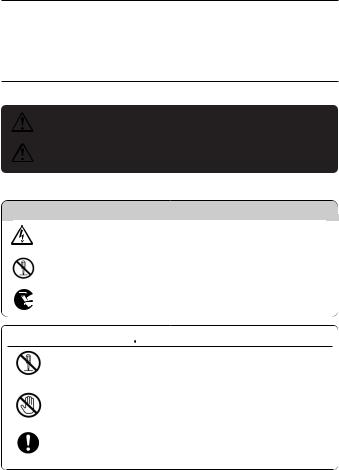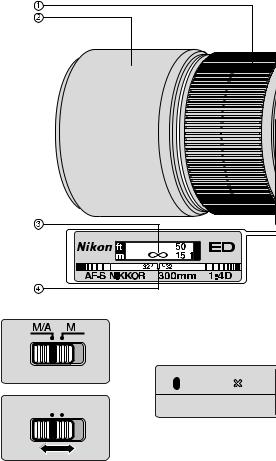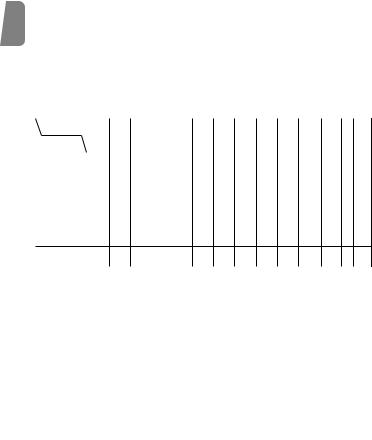Nikon AF-S NIKKOR 300MM F/4D IF-ED user Manual

AF-S Nikkor
300mm f/4D IF-ED
|
(P.6–11) |
||
Instruction Manual |
(PP.12–17) |
||
Bedienungsanleitung |
(S. 18–23) |
||
Manuel d'utilisation |
(P. 24–29) |
||
Manual de instrucciones |
(PP. 30–35) |
||
Manuale di istruzioni |
(PP. 36–41) |
||
|
|
|
(P. 42–46) |
|
|
|
(P. 47–51) |
|
|
|
|
Jp
En
De
Fr
Es
It
Ck
Ch

想定される内容および物的損害の発生が想定される内容を示しています。

●

すぐに修理依頼を
2


出す際、やけどに十分注意してください。電池を抜いて、販売店 またはニコンサービスセンターに修理を依頼してください。

あたらない所に保管すること
Ch
3

1
 3
3  2
2 






4

4
5

Jp |
1 |
! |
|
|
2 |
|
" |
|
3 |
|
#CPU |
|
4 |
|
$ EE |
|
5 |
|
% F |
|
6 |
|
& |
|
7 |
|
( |
|
8 |
|
) |
|
9 |
|
~ |
このレンズは、高速で静かなAF
●F6 F5 F4 F100 F90X F90 F80F70D U 600i SDX D2
D50 AF AFAF AF
● 3D 3D3D- BLAF F3AF
●
6

●CPU
●CPU PK-1 PK-11/11A JpBR-4 K1
●F3AF DX-1
|
|
|
|
|
|
M/A |
M |
F6 F5 F4 F100 F90X/F90 F80
F70D U 600iS D2 D1
D100 D70 D50
AF F3AF
C |
|
|
S |
|
|
AF |
|
|
M
C
AF |
|
M |
|
AF
F3AF
■M A
M A AFAF AF
1
■
M A
AF 3m“∞-3m”3m “FULL”( 2)
7

Jp
クレバーを絞りリングの方向にスライドし2 3
|
|
|
|
|
|
|
|
|
|
|
|
|
|
|
|
|
|
|
|
|
|
|
|
|
|
A |
B |
C |
D |
E |
EC-B |
F |
G1 |
|
G3 |
|
G4 |
H1 |
H3 |
J |
K |
L |
M |
P |
R |
U |
|
|
|
|
|
S |
|
||||||||||||||||||
|
|
|
|
|
|
|
EC-E |
|
G2 |
|
|
|
|
H2 |
H4 |
|
|
|
|
|
T |
|
|
|
F6 |
|
|
― |
― |
|
― |
― |
― |
|
― |
|
― |
― |
― |
|
― |
|
|
― |
― |
|
|
|
|
|
|
|
|
|
|
|
|
|
|
|
|
|
|
|
|
|
|
|
|
|
|
|
F5+DP-30 |
|
|
○ |
― |
|
|
― |
|
|
○ |
|
○ |
― |
― |
|
― |
|
|
― |
― |
|
|
|
|
|
|
|
|
|
|
|
|
+0.5 +0.5 |
|
|
|
|
|
|
|
+0.5 |
|||||
|
F5+DA-30 |
|
|
○ |
― |
|
|
― |
|
|
○ |
○ |
― |
― |
|
― |
|
|
― |
― |
|
||
|
|
-1.0 |
|
||||||||||||||||||||
|
F4+DP-20 |
― |
|
○ |
― |
|
― |
|
|
|
○ |
○ |
― |
― |
|
|
― |
|
|
― |
|||
|
|
|
|
+0.5 |
|
|
|
|
|
-1.0 |
|
|
|
+0.5 +0.5 |
|
|
+0.5 |
|
|
|
|||
|
F4+DA-20 |
― |
|
○ |
― |
|
― |
|
|
|
○ |
○ |
― |
― |
|
|
― |
|
|
― |
|||
|
-1.0 |
|
|
-1.0 -1.5 |
|
||||||||||||||||||
|
F3 |
|
|
○ |
○ |
|
― |
― |
|
|
○ |
○ |
|
○ |
|
|
|
|
|
||||
|
|
|
|
|
|
|
|
|
|
|
|
|
|
|
|
|
|
|
|
|
|
|
|
|
|
|
|
|
|
|
|
|
|
|
|
|
|
|
|
|
|
|
|
|
|
|
|
■
F6b6 B or E B E0 B or E F5
No.18 F4
M 1 1
8

B B2 B3 E E2 E3 K K2 K3F4 DP-20 B E K
Jp
4
1 1
2 2
2
33 90° 3
が外れてレンズ部が自重で下がり、他のものにぶつかると、損傷する恐れが あります。
9

● Jp
● ● L37C ● ● ● ●
● LF-1
10

77mm |
LF-1 |
Jp |
CL-M2 |
|
77mm TC-14BS TC-301S
AF-S TC-14E TC-17E TC-20ETC-17E TC-20E
|
F CPU D AF-S |
|
300mm |
|
1 : 4 |
|
6 10 ED 2 |
|
8°10′ DX |
|
5°20′IX240 6°40′ |
|
|
|
|
|
|
|
∞ 1.45m 5ft |
|
4 5.6 8 11 16 22 32 |
|
|
|
|
|
|
|
CPU AI |
|
|
|
|
|
Full ∞ 1.45m ∞ 3m 2 |
|
360° 90° |
|
|
77mm P = 0.75mm |
|
|
90mm × 222.5mm |
|
230.5mm |
|
1440g |
|
1300g |
11

Nomenclature
1Focus ring
2Lens hood
3Distance scale
4Distance index line
5Focus limit switch
En 6Focus mode switch
7Tripod collar alignment index
8Aperture index/Mounting index
9Minimum aperture lock lever !Aperture scale
"Aperture-direct-readout scale
#CPU contacts
$Minimum aperture signal post (EE servo coupling post)
%Aperture indexing post &Meter coupling ridge (Aperture ring
)Tripod collar lock screw ~Detachable tripod collar
Introduction
Thank you for purchasing the AF-S Nikkor 300mm f/4D IF-ED. This is a high-grade, internal focusing (IF) lens employing a Silent Wave Motor to drive the focusing mechanism, thus the “S” designation. As a result, autofocusing is smooth, silent, and almost instantaneous.
Major features
•Autofocusing possible with Nikon F6, F5, F4-Series, F100, F90X/N90s*, F90Series/N90*, F80-Series/N80-Series*, F70-Series/N70*, F65-Series/N65-Series*, Pronea 600i/6i* and Pronea S cameras, and Nikon digital SLR (Nikon DX format) cameras, such as the D2-Series and D50. Also provided: autofocusing with manual override and autofocus range limiting via a focus limit switch.
•Manual focusing using focus assist as well as autofocusing possible with all Nikon AF camera bodies, except the F3AF.
•For more accurate exposure control, subject distance information is transmitted from the lens to the camera body, providing 3D Matrix Metering and 3D MultiSensor Balanced Fill-Flash with appropriate Nikon cameras and Speedlights.
*Sold exclusivley in the USA.
12

Important!
•Be careful not to soil or damage the CPU contacts.
•Do not attach the following accessories to the lens, as they might damage the lens CPU contacts: Auto Extension Ring PK-1, PK-11/11A, Auto Ring BR-4, and K1 Ring.
Other accessories may not be suitable when this lens is used with certain camera bodies. For details, refer to instruction manual for each product.
•This lens is not compatible when used with a Nikon F3AF camera with the AF En Finder DX-1 attached.
Focusing
Set your camera’s focus mode selector according to this chart:
Camera’s focus mode |
Lens’ focus mode |
||
Cameras |
|
M/A |
M |
F6, F5, F4-Series, F100 F90X/N90s*, |
C |
Autofocus with |
Manual focus |
F90-Series/N90*, |
S |
manual priority |
(Focus assist is available.) |
F80-Series/N80-Series*, |
AF |
|
|
F70-Series/N70*, |
|
|
|
|
Manual focus |
|
|
F65-Series/N65-Series*, Pronea 600i/6i*, |
M |
|
|
Pronea S, D2-Series, D1-Series, D100, |
(Focus assist is available.) |
||
D70-Series, D50 |
|
|
|
Nikon AF cameras |
C |
Manual focus |
|
(except for F3AF) |
S |
(Focus assist is available.) |
|
|
AF |
|
|
|
M |
|
|
Other Nikon cameras (except for F3AF) |
|
|
Manual focus |
|
|
|
|
* Sold exclusively in the USA.
•Autofocus with manual override
Set the focus mode switch (Fig. 1) to M/A. Autofocus is provided, but you can manually override the focus by operating the separate manual focus ring while lightly depressing the shutter release button or the AF start (AF-ON) button on the camera body of cameras so equipped. To cancel manual override, remove your finger from the shutter release button or the AF start button.
•To limit the range of autofocus (for M/A mode usable cameras only)
Move the focus limit switch (Fig. 2) from FULL to ∞ -3m to reduce autofocus time. This is useful when shooting subjects farther away than 3m (9.8 ft.). Set the switch to FULL when your subjects are closer than 3m.
13

Depth of Field
If your camera has a depth of field preview (stop-down) button or lever, depth of field can be observed while looking through the camera viewfinder.
Minimum Aperture Lock (Fig. 3)
For programmed auto or shutter-priority auto exposure shooting, use the minimum aperture lock lever to lock the lens aperture at f/32.
En 1 Set the lens to its minimum aperture (f/32) by aligning it with the aperture index. 2 Slide the lock lever toward the aperture ring, so the two orange dots are aligned. To release the lock, slide the lever in the opposite direction.
Recommended Focusing Screens
Various interchangeable focusing screens are available for certain Nikon SLR cameras to suit any picture-taking situation. The ones recommended for use with this lens are:
|
|
|
|
|
|
|
|
|
|
|
|
|
|
|
|
|
|
|
|
|
|
|
|
|
Screen |
A |
B |
C |
D |
E |
EC-B |
|
G1 |
|
G3 |
|
G4 |
H1 |
H3 |
|
|
|
|
|
R |
|
|
|
|
F |
|
|
J |
K |
L |
M |
P |
S |
U |
|
|||||||||||
|
Camera |
EC-E |
G2 |
|
|
H2 |
H4 |
|
|||||||||||||||
|
|
|
|
|
|
|
|
|
|
|
|
|
|
|
|
|
|
|
|
T |
|
|
|
|
F6 |
|
|
― |
― |
|
― |
― |
― |
|
― |
|
― |
― |
― |
|
― |
|
|
― |
― |
|
|
|
|
|
|
|
|
|
|
|
|
|
|
|
|
|
|
|
|
|
|
|
|
|
|
|
F5+DP-30 |
|
|
○ |
― |
|
|
― |
|
|
○ |
|
○ |
― |
― |
|
― |
|
|
― |
― |
|
|
|
|
|
|
|
|
|
|
|
|
+0.5 +0.5 |
|
|
|
|
|
|
|
+0.5 |
|||||
|
F5+DA-30 |
|
|
○ |
― |
|
|
― |
|
|
○ |
○ |
― |
― |
|
― |
|
|
― |
― |
|
||
|
|
-1.0 |
|
||||||||||||||||||||
|
F4+DP-20 |
― |
|
○ |
― |
|
― |
|
|
|
○ |
○ |
― |
― |
|
|
― |
|
|
― |
|||
|
|
|
|
+0.5 |
|
|
|
|
|
-1.0 |
|
|
|
+0.5 +0.5 |
|
|
+0.5 |
|
|
|
|||
|
F4+DA-20 |
― |
|
○ |
― |
|
― |
|
|
|
○ |
○ |
― |
― |
|
|
― |
|
|
― |
|||
|
-1.0 |
|
|
-1.0 -1.5 |
|
||||||||||||||||||
|
F3 |
|
|
○ |
○ |
|
― |
― |
|
|
○ |
○ |
|
○ |
|
|
|
|
|
||||
|
|
|
|
|
|
|
|
|
|
|
|
|
|
|
|
|
|
|
|
|
|
|
|
|
|
|
|
|
|
|
|
|
|
|
|
|
|
|
|
|
|
|
|
|
|
|
|
Excellent focusing
○Acceptable focusing
Slight vignetting or moiré patterns appear in the viewfinder, but not on the film.
―Not available.
( ) Indicates degree of exposure compensation needed (Center-Weighted metering only). For F6 cameras, compensate by selecting “Other screen” in Custom Setting “b6: Screen comp.” and setting the EV level to -2.0 to +2.0 in 0.5 EV steps. When using screens other than type B or E, “Other screen” must be selected even when the required compensation value is “0” (no compensation required). For F5 cameras, compensate using Custom Setting #18 on the camera body. For F4-Series cameras, compensate using the Exposure Compensation Dial for the focusing screen.
See instruction manual of the camera body for more details.
Blank box means not applicable. Since type M screen can be used for both macrophotography at a 1:1 magnification ratio and for photomicrography, it has different applications than other screens.
When using the B/B2/B3, E/E2/E3, and K/K2/K3 focusing screens in cameras other than those listed above, refer to the columns on the F4 + DP-20’s B, E and K screens, respectively.
14

Taking Flash Pictures with Cameras having Built-in flash
All Nikon cameras having built-in flash are usable and no vignetting occurs.
Using a Tripod (Fig. 4)
This lens is equipped with a detachable rotating tripod collar. When using a tripod, |
|
attach it to the lens’ tripod collar instead of the camera. To attach the tripod collar to |
|
the lens, follow these steps: |
En |
1 Loosen the tripod collar lock screw 1slightly. |
2Insert the lens by aligning the tripod collar alignment index on the lens with the mark  on the tripod collar. 2
on the tripod collar. 2
3Turn the lens to an appropriate position index 3(three indexes are provided every 90°) on the tripod collar by aligning the tripod collar alignment index on the lens, then tighten the screw. (If the screw is not tight, the lens may accidentally come off the tripod collar.)
When holding your camera by its handgrip and rotating the camera in its tripod collar, your hand may bump into the tripod, depending on the tripod in use.
Lens Hood
Pull out the lens hood by rotating it slowly until the click-stop position is released and the hood moves smoothly. Then, turn it counterclockwise (as viewed from the front) to secure it in the extended position. Because the lens hood is not detachable, slide it back to its click-stop position when not in use. Never lift the lens by its hood. This may cause the lens to drop, due to its own weight, and become damaged, if it hits something hard.
15

Lens Care
•Clean the lens surface with a blower brush. To remove dirt and smudges, use a soft, clean cotton cloth or lens tissue moistened with ethanol (alcohol) or lens cleaner. Wipe in a circular motion from center to outer edge, taking care not to leave traces or touch other parts.
•Never use thinner or benzene to clean the lens as this might damage the lens, result in a fire, or cause health problems.
En •To protect the front lens element, an NC filter is recommended at all times. A lens hood also helps protect the front of the lens.
•When storing the lens in the lens case, attach both front and rear caps. •When the lens will not be used for a long time, store it in a cool, dry place to
prevent mold. Also store the lens away from direct sunlight or chemicals such as camphor or naphthalene.
•Do not get water on the lens or drop it in water as this will cause it to rust and malfunction.
•Reinforced plastic is used for some parts of the lens. To avoid damage, never leave the lens in an excessively hot place.
•Never use an air blower to clean the inside rear portion of the lens.
Because the diaphragm blades are exposed, they may be damaged by a strong burst of air. Also be sure to attach the rear lens cap LF-1 when the lens is not in use to protect the lens and diaphragm blades from foreign matter and fingerprints.
Supplied Accessories
77mm snap-on front lens cap Rear lens cap LF-1 Semi-soft case CL-M2
Optional Accessories
77mm screw-in filters, including circular polarizing filter II
Teleconverters TC-14B, TC-301, AF-S Teleconverters TC-14EII, TC-17EII, TC-20EII (Do not use the TC-17EII and TC-20EII for autofocus operation.)
16

Specifications
Type of lens: |
D-type AF-S Nikkor lens having built-in CPU and |
|
|
Nikon bayonet mount |
|
Focal length: |
300mm |
|
Maximum aperture: |
f/4 |
|
Lens construction: |
10 elements in 6 groups (2 ED elements) |
|
Picture angle: |
8°10´ [5°20´ with Nikon digital cameras (Nikon DX |
En |
|
format); 6°40´ with IX240 system cameras] |
|
Distance information: |
Output to camera body |
|
Focusing: |
Nikon Internal Focusing (IF) system (utilizing an |
|
|
internal Silent Wave Motor); manually via separate |
|
|
focus ring |
|
Shooting distance scale: |
Graduated in meters and feet from 1.45m (5 ft.) to |
|
|
infinity (∞ ) |
|
Aperture scale: |
f/4– f/32 on both standard and aperture-direct- |
|
|
readout scales |
|
Minimum aperture lock: |
Provided |
|
Diaphragm: |
Fully automatic |
|
Exposure measurement: |
Via full-aperture method with AI cameras or |
|
|
cameras with CPU interface system; via stop-down |
|
|
method for other cameras |
|
Focus limit switch: |
Provided; two ranges available: FULL (infinity to |
|
|
1.45m [4.8 ft.]) or ∞ – 3m (9.8 ft.) |
|
Tripod mounting: |
Detachable tripod mounting collar; rotatable |
|
|
through 360°, indices every 90° |
|
Attachment size: |
77mm (P = 0.75mm) |
|
Dimensions: |
Approx. 90mm dia. x 222.5mm extension from the |
|
|
camera’s lens mounting flange; overall length is |
|
|
approx. 230.5mm |
|
Weight: |
Approx. 1440g (50.8 oz.) with tripod collar; |
|
|
approx. 1300g (45.9 oz.) for lens only |
|
17
